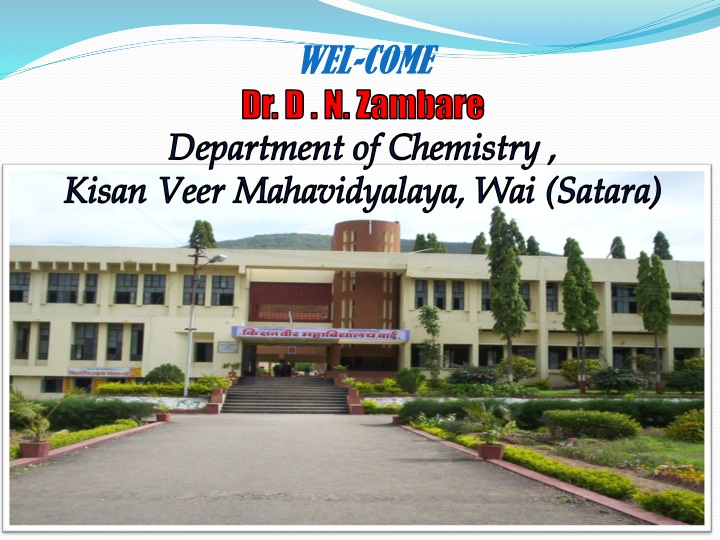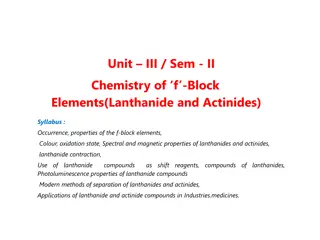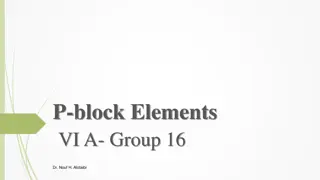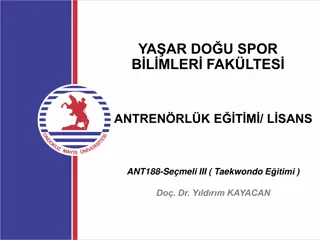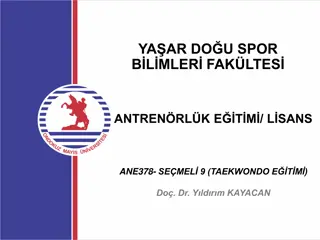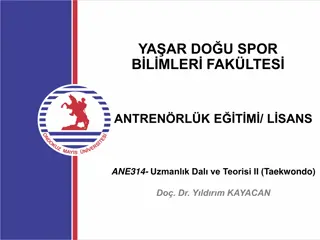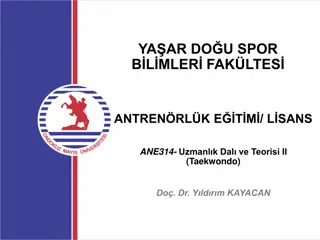General Overview of p-Block Elements in Chemistry
p-block elements in the periodic table include metals, non-metals, metalloids, and noble gases from Group IIIA to Group VIIA. This group of elements has unique electronic configurations, properties, and characteristics, making them essential in understanding chemical behavior. The content discusses the general electronic configuration, compounds of specific elements like boron and nitrogen, and comparative studies of different groups based on atomic radii, oxidation states, ionization potential, electronegativity, and reactivity.
Download Presentation

Please find below an Image/Link to download the presentation.
The content on the website is provided AS IS for your information and personal use only. It may not be sold, licensed, or shared on other websites without obtaining consent from the author.If you encounter any issues during the download, it is possible that the publisher has removed the file from their server.
You are allowed to download the files provided on this website for personal or commercial use, subject to the condition that they are used lawfully. All files are the property of their respective owners.
The content on the website is provided AS IS for your information and personal use only. It may not be sold, licensed, or shared on other websites without obtaining consent from the author.
E N D
Presentation Transcript
WEL-COME Dr. D . N. Zambare Department of Chemistry , Kisan Veer Mahavidyalaya, Wai (Satara)
Chapter 3p-block Elements Contents 3.1 3.2 Characteristics of p-block Elements with Special Reference to Electronic Configuration and Periodic Properties 3.3 Compounds of Group 13, 14 and 15 3.3.1 Boron-Diborane Method of Preparation and Nature of Bonding (Structure) 3.3.2 Borazine Method of Preparation and Nature of Bonding (Structure) 3.3.3 Allotropes of Carbon and Phosphorus 3.3.4 Oxyacids of Nitrogen - HNO2, HNO3 3.3.5 Hydrides of Nitrogen - NH3 and N2H4 Position of Elements in Periodic Table
Introduction : The elements of Group IIIA to Group VIIA including Group zero elements of the periodic table are known as p- block elements. These elements are also known as post- transitional elements as most of them follow the transition elements in the periodic table. These elements lie on the extreme right of the periodic table. The p-block consists of metals, non-metals, metalloids and nobel gases. 3.1 General Electronic Configuration : The general electronic configuration for Group IIIA to group VIIA and zero group (13 to 18) is ns2np1 to ns2 np5 and ns2 np6; where n is the principal quantum number. With the exception of He whose configuration is 1s2. For the member of p-block elements, the differentiating electron enters 2p-, 3p-, 4p-, 5p- and 6p orbitals respectively.
The characteristic general electronic configuration for these elements may be tabulated as in Table 3.1 given below. Table 3.1 : General Electronic Configuration of p-Block Elements: Group (13) IIIA (14) IV A (15) V A (16) VI A (17) VII A ns2 np1 ns2 np2 ns2 np3 ns2 np4 ns2 np5 Characteristic electronic B 2s2 2p1 C 2s2 2p2 N 2s2 2p3 O 2s2 2p4 F 2s2 2p5 Al 3s2 3p1 Si 3s2 3p2 P 3s2 3p3 S 3s2 3p4 Cl 3s2 3p5 configuration Ga 4s2 4p1 Ge 4s2 4p2 As 4s2 4p3 Se 4s2 4p4 Br 4s2 4p5 In 5s2 5p1 Sn 5s2 5p2 Sb 5s2 5p3 Te 5s2 5p4 I 5s2 5p5 Tl 6s2 6p1 Pb 6s2 6p2 Bi 6s2 6p3 Po 6s2 6p4 At 6s2 6p5 Because of similarities in the electronic configurations, the similarities in chemical behavior of each group is expected
3.2 Comparative Study of Groups The comparative study of groups (Group IIIA to Group VII A elements) is to be done w. r. t. (a) Atomic and Ionic radii, (b) Oxidation states, (c) Ionization potential/ Ionization energy (d) Electronegativity (e) Reactivity Let us study each group one by one. 3.2.1 Group III A Elements The Group III A contains five elements, namely boron (B), aluminium (Al), gallium (Ga), indium (In) and thallium (Ti). See Table 3.2. Element Boron (B) (Al) Aluminium Gallium (Ga) Indium (In) Thallium (T ) Atomic weight 5 13 31 49 81 Electronic configuration [He] 2s2 2p1 [Ne] 3s2 3p1 [Ar] 4s2 4p1 [Kr] 5s2 5p1 [Xe] 6s2 6p1 Atomic Radii (pm) 82 118 126 144 148 Ionic Radii (pm) (Trivalent Ion ) 20 50 62 80 95 Oxidation states +3 +3 +1, +3 +1, +3 +1, +3 (First) Ionization (Potential) Energy kJ mol 1 800 577 579 558 589 Electronegativities 2 1.5 1.6 1.7 1.8
(i) atomic and ionic radii increase down the group. The increase in size from B to Al is more as compared to increase in size from Ga to Tl. It is because of following reasons. 1. Shielding ability of electrons in the order of s > p > d > f. 2. There is an absence of d10 core of electrons in the penultimate shell of B and Al while the penultimate shell of rest of the elements contain d10 electrons. Hence in Ga, In and Tl, the outermost valency electrons are more firmly held by the nuclei. Thus the d10 electrons containing elements are smaller in size. In other words, the atomic and ionic radii of Group IIIA elements do not increase in a regular pattern. Refer Table 3.2. (ii) Oxidation States: When all the three electrons of the valence shell (i.e. ns2 np1) are removed, we get +3 oxidation state. This is the most common and stable oxidation state shown by Group IIIA elements. The boron atom has small size and high ionization energy. Hence, it does not lose all its valency electrons (ns2np1). It does not show +3 oxidation state. For this reason boron combines with other elements through covalent bonds The heavy elements Ga, In, Tl show +1 as well as +3 oxidation states. Hence these elements form M+ as well as M3+ cations. The M+ cations are formed by the loss of np1 electron while the electron pair in ns orbital remains inert. This is known as inert pair effect. B and Al atoms do not show inert pair effect and hence do not form M+ cations. This effect increases from Ga to Tl. From B to Tl, the stability of +3 oxidation state decreases while that of +1 oxidation state increases. B+3 > Al+3 > Ga+3 > In+3 > Tl+3 stability decreases B+ < Al+ < Ga+ < In+ < Tl+ stability increases Atomic and Ionic Radii: The atomic number and number of energy shell increase from B to Tl, hence the
(iii) Ionization Potential/Ionization Energy: The Group IIIA elements have two s-electrons and one p-electron in their outermost shells. The p-electrons are less penetrating as compared to s- electrons. They are farther away fromthe nucleus. Hence p-electrons are held less tightly then s-electrons. The first ionization potentials of these elements are therefore low. The second and third ionization potential are however considerably higher because successive electrons have to be pulled out of the stable s-orbitals. In Group IIIA, ionization potential gradually decreases from B to Tl because of effect of increasing atomic size is more than that of nuclear charge. The ionization potential remains practically same in spite of increase in atomic size as we move from Al to Ga. The last element Tl, has 14 f- electrons in its inner electronic configuration. Since the shielding effect of f-electrons is much smaller than that of d-electrons and also since there is only a marginal increase in atomic size as we move from In to Tl, the outer electron in Tl is held quite firmly. Hence, there is a considerable increase in its ionization potential. Refer Table 3.2.
(iv)Electronegativity: Electronegativity decreases from B (2.0) to Al (1.5) because of increase in size. Gallium which is next to aluminium shows slight increase (1.6) in electronegativity. This is rather unexpected. The remaining two elements show slight fall in these values. Thus the electronegativity value does not fall as expected. This is due to the presence of extra d10 or f14 electrons, which screen the nuclear charge effectively. Boron having high electronegativity when combines with other non-metals, bonds are covalent with less polarity as the electronegativity difference between the combining atoms is not very great. From boron to thallium, the bonds with non-metals are less covalent and more polar as the electronegativity difference between the combining atoms goes on increasing. (v)Reactivi ty: These elements are less electropositive (i.e. less basic), hence are less reactive. They are chemically reactive at high temperature. Though the size of atoms increases regularly from aluminium to thallium, the ionization potential values do not show regular decrease. Hence the reactivity of Group IIIA elements does not increase regularly from aluminium to thallium. These elements show greater tendency for the formation of covalent complex compounds. Aluminium is stable in air because it develops an oxide film which protects the metal from further attack. But amalgamated aluminium is rapidly oxidized and decomposes cold water. Gallium and indium are stable in air and are not attacked by water except when free oxygen is present. These elements, especially boron and aluminium form electron deficient molecules by forming sextet of electrons. Such compounds can readily form co-ordinate compounds.
3.2.2 Group IVA Elements The Group IVA consists of five elements namely carbon (C), silicon (Si), germanium (Ge), tin (Sn) and lead (Pb). For details, Refer Table 3.3. Table 3.3: Group IV A Elements Element Carbon Silicon Germaniun Tin Lead (C) (Si) (Ge) (Sn) (Pb) Atomic weight 6 14 32 50 82 Electronic [He] Ne] [Ar] [Kr [Xe] 2s2 2p2 3s2 3p2 3d10 4s2 4p2 4d10 5s2 5p2 4f14 5d10 6s2 6p2 configuration Atomic Radii (pm) 77 111 122 141 144 Ionic Radii (pm) (Trivalent Ion ) Oxidation states +4 +4 +2, +4 +2, +4 +2, +4 (First) Ionization 1086 786 761 708 716 (Potential) Energy kJ mol 1
(i) Atomic and ionic radii: Size of atom and ions go on increasing from C to Pb. The diffrence in size between Si and Ge is less than the expected value, while it is more for C and Si. There is a less difference in size between Sn and Pb due to filling of 4f shell. (ii) Oxidation State: Inert Pair effect and positive oxidation state: C and Si show +4 oxidation state while Ge, Sn and Pb show +2 as well as +4 oxidation state. When only two np electrons from the ns2 np2 configuration are lost, the elements show +2 oxidation state. Here two ns2 electrons remain inert and are not lost. This is called inert pair effect. This pair of ns2 electrons is called inert pair electron. The stability of inert pair of electron increases on moving down the group. The stability of +2 oxidation state also increases on moving down the group i.e. Ge2+ < Sn2+ < Pb2+ When all the four ns2 np2 electrons are lost, the elements shows +4 oxidation state. The stability of +4 oxidation state decreases from Ge4+ to Pb4+ i.e. Ge4+ > Sn4+ > Pb4+ The compounds of Sn2+ (e.g. SnCl2) are less stable than those of Sn4+ (e.g. SnCl2). Hence the compounds of Sn2+ are readily changed (oxidized) into those of Sn4+.
(iii) Ionization Potential: The ionization potential decreases from C to Pb because of increase in atomic size. The decrease does not have a regular order. The irregularity in the decrease of these values is due to the filling of intervening d-orbitals in the case of Ge and Sn while f-orbitals in case of Pb, which are not able to screen the valence electrons effectively. (iv) Electronegativity: Carbon is most electronegative element of this group and the electronegativities decrease with rise in atomic number. But after Si, electronegativity increases slightly. It is due to the filling of the d-orbitals in the case of Ge and Sn and f-orbitals in the case of Pb. (v) Reactivity: The Group IV A elements are not very reactive. Their chemicals reactivity increases from C to Sn. Lead (Pb) is least reactive. When these elements are heated with oxygen or halogens then they combines with them by utilizing their four valence electrons. Lead is exception for this due to inert pair effect. These elements are attacked by strong acids, alkalis and most electronegative elements such as oxygen and halogens.
3.2.3 Group VA Elements Group VA of the periodic table consist of five elements, namely nitrogen (N), phosphorus (P), arsenic (As), antimony (Sb) and bismuth (Bi). Table 3.4 : Group VA Elements Element Nitrogen (N) Phosphorus (P) Arsenic (As) Antimony (Sb) Bismuth (Bi) Atomic weight 7 15 33 51 83 [He] 2s2 2p3 [Ne] 3s2 3p3, [Ar] 3d10 4s2 4p3 [Kr] 4d10 5s2 5p3 [Xe] 4f14 5d10 6s26p3 Electronic configuration Atomic Radii (pm) 75 106 119 138 146 Ionic Radii (pm) 171 212 222 245 120 (Trivalent Ion ) Oxidation states 3, +1, +2, +3, +4, +5 3, +3, +4, +5 3, +3, +5 3, +3, +5 +3, +5 (First) Ionization 1402 1012 946 840 703 (Potential) Energy kJ mol 1 Electronegativities 3.0 2.1 2.0 1.8 1.7
(i) Atomic and Ionic Radii: The atomic and ionic radii increases from N to Bi. The difference in size between P and As is less than expected value because the process of filling of 3d shell causes ineffective screening though the nuclear charge increase. Similarly, the small difference in size between antimony and bismuth is due to the filling of 4f shell. The same trend is true for the ion of these elements. (ii) Oxidation States: 1. The characteristic electronic configuration ns2 np3 of Group VA elements suggest that 1. By gaining three electrons they form trivalent negative ions (M3 ). 2. By sharing three electrons, they form covalent bonds with oxidation state 3. 3. Form pentavalent cations (M5+) by losing five valence electrons to complete octet of these elements. 2. By sharing three electrons, they form covalent bonds with oxidation state 3. 3. Form pentavalent cations (M5+) by losing five valence electrons to complete octet of these elements. The stability of paired ns2 electrons increases with increase in atomic number and atomic size. Thus it becomes maximum in bismuth. It is known as inert pair effect. Because of this reason, the stability of +3 oxidation state increases and +5 oxidation state decreases with increase in atomic number. Hence trivalent bismuth compounds are more stable than the pentavalent compounds. The compounds with oxidation state (+5) are unknown because very high energy is required to remove five electron from ns2, np3 configurations.
(iii) Ionization Potential: With the increase of size from N to Bi, the value of first ionization potential decreases on descending the group. The fall in ionization potential is appreciable from N to P while it is slight from As to Bi because of filling of d and f orbitals. The ionization potentials of Sb and Bi are low. (iv) Electronegativity: The electronegativity decreases from nitrogen to phosphorous because of increase in size. But the decrease in the electronegativity does not fall so rapidly in the subsequent elements though the trend continues. It is due to presence of d and f electrons in the penultimate and prepenultimate shells showing ineffective screening even though the nuclear charge increases. (v) Reactivity: The Group VA elements are less reactive because of presence of ns2 np3 configuration, where s-orbitals are full and p-orbitals are half-filled which have thus acquired special stability. The nitrogen is diatomic molecule with a triple bond. The bond dissociation energy of nitrogen molecule is high. It suggests the stability and inactivity of nitrogen. Hence nitrogen is accumulated in large amounts in atmospheres.
3.3 Compounds of Groups 13, 14 and 15: Boron-Diborane Method of Preparation and Nature of Bonding (Structure) : Diborane : B2H6 Method of Preparation: 1. Diborane can be obtained by reducing BF with LiAlH in diethyl ether. 4BF + 3LiAlH 2B H6+ 3LiF + 3AlF 2. In laboratory, diborane is prepared by the oxidation of sodium borohydride with iodine. 2NaBH + I B H6+ 2NaI + H 3. In industry, diborane is prepared by the reaction of BF with sodium hydride. 2BF + 6NaH B H6 + 6Na Structure of Diborane: A successful attempt has been made by Hedberg and Schomaker in 1950 to give correct structure for diborane. It is based on concept of 3C-2e bonding involving hydrogen bridge bonds. The study covers nearly all the experimental investigations such as X-ray diffraction, electron diffraction, NMR, IR and Raman spectra, etc. (a) Bond characteristics: Result of electron diffraction, indicates the structure for diborane as shown in Fig. 3.1 The bond characteristics indicated experimentally are : (i) The terminal B H distance is 119 pm, the same as the bond length measured in non-electron-deficient compound
(ii)The bridge B H distance is 133 pm, which indicates electron deficiency, being quite larger than the terminal B H distance. (iii)The B H B bridge bond is 266 pm. It indicates no direct linking for B and B. (iv) The outer H B H angle is 121.5o, the inner H B H angle is 97o while the B H B angle is 110o. (b) Probability of Bridge Bonding: (i)Further the result of electron diffraction indicate that the B2H6 molecule contains two coplanar BH2 units, one on the left and other on the right and four H atoms called terminal hydrogens lie in a different environment from the other two. While the two H atoms called bridging atoms lie in a plane perpendicular to the BH2 plane and prevent free rotation of B2H6 molecule between the two B atoms. (ii) Specific heat measurements also supports that the free rotation of the molecule about B B bond is hindered. This fact confirm the presence of bridging atoms in B2H6. (iii) There are four H atoms of one type and two of other type has been further confirmed by Raman, IR and NMR spectroscopy (iv) Diborane can not be methylated beyond Me4B2H2 without breaking the molecule into two BMe3. This confirms the presence of two bridging H atoms in B H
(c) Counting of Bond Order: (i) Diborane is thermly quite stable upto 373 K (100 C). (ii)B2H6 is a diamagnetic molecule. All the electrons in diborane must be paired up. (iii)There are 12 electrons in the valence shell of B2H6 three each from 2 B atoms and 1 each from 6 H atoms. Thus, one msy expect six covalent bonds in B2H6. (d)Nature of H-Bridge Bond : From above discussion it is evident that the electron deficient must be associated with the bridge groups, the nature of which is well established. For diborane, instead of a simple valence bond structure, relatively a more logical molecular orbital picture is preferred. For diborane, the concept of three centre two electron bond (3C-2e) is adopted to account for bridge bonding. The three centre molecular orbital s composed of and sp3 hybrid orbital from one boron, plus a 1s of a bridging H, plus an sp2 or sp3 of the other boron, giving rise to a delocalized MO, with one pair of electrons, that covers all the three nuclei and forms one of the H-bridge bond. See Fig. 3.2.
There are three centre hydrogen bridge bonds in diborane. The bridge bonds involve four electrons, one from each boron and one from each bridging hydrogen atom. These bonds are frequently called as banana shaped bonds. This molecular orbital concept provides a proper electron count and is consistent with all the observed facts such as reactivity, diamagnetism, structural differences between H-atoms, etc. for diboron.
(i) A symbol His introduced to represent three-centre orbital involving H atoms. On this basis, in 1963, Lipscomb has suggested a semi-topological scheme to represent various boranes. Accordingly, diborane with a modified valence bond presentation may be given as shown in fig. (ii) A more simple picture of 3C 2e bonding in B2H6 may be given as follows :
3.3.2 Borazine (B3N3H6) : Method of Preparation: century. It was first made by Stock and Pohland in 1926 by heating diborane with ammonia at 398 K (125 C). 3B2H6 + 6NH3 3(B2H6)(NH3)2 B3N3H6 + 12 H2 Structure and Bonding: Ground State : B(Z = 5) = 1s2 2s2 2p Valence State : B (Z = 5) = 1s2 2s1 2p Borazine is known since the pioneering work of Alfred Stock, early in this 1 x; 1 x2p 1 y 2p 1 z N(Z = 7) = 1s2 2s2 2p N (Z = 7) = 1s2 2s1 2p 1 x2p 1 y 2p 0 z; 1 x2p 1 y 2p 2 z BNB = < NBN = 120o, with each other. Each boron and nitrogen must be forming three bonds and one bond. In the formation of dative covalent bond, nitrogen must be acting as a donor while boron an acceptor. The arrangement of B and N atoms is, therefore, a regular hexagonal planar. The pz orbitals not involved in hybridization, are at right angles to the plane of molecule and are interconnected just similar to the pz orbitals on carbon atoms in benzene ring and account for mobile electron cloud. sp2 Hybridization sp2 Hybridization According to VBT, both B and N must be using sp2 hybrid orbitals leading to <
The Raman and IR spectra of borazine indicate a planer hexagonal arrangement exactly comparable to that of benzene. The bond angle is 120o, the B N bond distance to be 144 pm. It lies between the expected single bond distance, (B N) 154 pm [160 pm found in H3N BF3] and double bond distance, (B = N) 136 pm. The N H and B H distances are found to be 102 pm and 120 pm respectively. The shortening of (B N) distance can be attributed to the p p bonding delocalized over entire ring. Refer Fig. 3.6. Borazine is isoelectronic and isostructural with organic benzene. Benzene (C6H6) : (6 6) + (1 6 ) = 42 Borazine (B3N3H6) : (3 5) + (3 7) + (1 6) = 42 As far as delocalized electron cloud and aromatic character is concerned, its structure shows formal similarity with benzene, leading to its reference as Inorganic Benzene . Refer Fig. 3.6.
Structure and Properties: As far as physical properties are concerned, borazine is indeed a close analogue of benzene. This similarity of physical properties has been overemphasized and led E. Wiberg to describe it as inorganic benzene. From ring structures shows in fig., it appears that borazine is an imperfect analogue of benzene. This is evident from the fact that the chemical properties of borazine and benzene are quite different. This may be accounted from structure and bonding as follows : In borazine aromatic pi electron cloud is delocalized over all the ring atoms, no doubt. But there is a difference in electronegativity between Boron (2) and Nitrogen (3). Hence the pi cloud in borazine is lumpy (uneven) ; it is localized more on nitrogen and less on boron. This partial localisation weakens the pi bonding in the ring. In addition , nitrogen retains some of its basicity (donor character). When polar species such as HCl attack the double bond the different electronegativities of B and N cause bonding to boron by electronegative substituent and to nitrogen by electropositive substituent. Thus in contrast to benzene, borazine readily undergoes addition reaction, showing a high degree of unsaturation
The polarity of BN bond is a combined effect of an electron drift from B to N associated with the bond and from N to B associated with the bond. This leads to the structural representation of borazine as the Kekule type resonance hybrid as shown in fig below. The further support to very structure of borazine may be collected from the structural study of substituted borazine and borazine analogues of naphthalene, biphenyl, cyclohexane, etc.
Some of these are as follows: 3.3.3 Allotropes of Carbon and Phosphorus The elements having same chemical composition but having different physical forms, such a different forms of elements are called as allotropes. These allotropes are having differents properties. (A) Allotropes of Carbon: Carbon has several allotropes, or different forms in which it exists. Interestingly, carbon allotropes span a wide range of physical properties: diamond is the hardest naturally occurring substance, and graphite is one of the softest known substances. Diamond is transparent, the ultimate abrasive, and can be an electrical insulator and thermal conductor. Conversely, graphite is opaque, a very good lubricant, a good conductor of electricity, and a thermal insulator. Allotropes of carbon are not limited to diamond and graphite, but also include buckyballs (fullerenes), amorphous carbon, glassy carbon, carbon nanofoam, nanotubes, and others.
Fig. 3.7: Allotropes of Carbon: Some allotropes of carbon: (a) Diamond, (b) Graphite, (c) Lonsdaleite, (d f) fullerenes (C60, C540, C70); (g) Amorphous carbon, (h) Carbon nanotube
1.Diamond: tetrahydron units combine together and give a joint crystal of diamond. The structure of diamond produces by sp3 hybridisation of carbon. Planty of Diamond is probably the most well known carbon allotrope. The carbon atoms are arranged in a lattice, which is a variation of the face-centered cubic crystal structure. It has superlative physical qualities, most of which originate from the strong covalent bonding between its atoms. Each carbon atom in a diamond is covalently bonded to four other carbons in a tetrahedron. These tetrahedrons together form a three- dimensional network of six-member carbon rings in the chair conformation, allowing for zero bond-angle strain. This stable network of covalent bonds and hexagonal rings is the reason that diamond is so incredibly strong as a substance. As a result, diamond exhibits the highest hardness and thermal conductivity of any bulk material. In addition, its rigid lattice prevents contamination by many elements. The surface of diamond is lipophillic and hydrophobic, which means it cannot get wet by water but can be in oil. Diamonds do not generally react with any chemical reagents, including strong acids and bases. Uses of diamond include cutting, drilling, and grinding, jewellery, and in the semi-conductor industry. Carbon has an electronic arrangement of 2, 4. In diamond, each carbon shares electrons with four other carbon atoms - forming four single bonds.
Physical Properties of Diamond: It has a very high melting point (almost 4000 C). Very strong carbon-carbon covalent bonds have to be broken throughout the structure before melting occurs. It is very hard. This is again due to the need to break very strong covalent bonds operating in 3-dimensions. It does not conduct electricity. All the electrons are held tightly between the atoms, and aren't free to move. It is insoluble in water and organic solvents. There are no possible attractions which could occur between solvent molecules and carbon atoms which could outweigh the attractions between the covalently bound carbon atoms. 2. Graphite: The structure of graphite is produced by union of infinite number of hexagonal rings. Each hexagonal ring is produced by sp2 hybridisation in carbon. Plenty of hexagon units combine together and give a continuous sheet of graphite. Several such sheets unit together and give a flaky graphite crystal.
There are three types of natural graphite: Crystalline flake graphite: isolated, flat, plate-like particles with hexagonal edges Amorphous graphite: fine particles, the result of thermal metamorphism of coal; sometimes called meta-anthracite Lump or vein graphite: occurs in fissure veins or fractures, appears as growths of fibrous or acicular crystalline aggregates Graphite has a layered, planar structure. In each layer, the carbon atoms are arranged in a hexagonal lattice with separation of 0.142 nm, and the distance between planes (layers) is 0.335 nm. The two known forms of graphite, alpha (hexagonal) and beta (rhombohedral), have very similar physical properties (except that the layers stack slightly differently). The hexagonal graphite may be either flat or buckled. The alpha form can be converted to the beta form through mechanical treatment, and the beta form reverts to the alpha form when it is heated above 1300 C. Graphite can conduct electricity due to the vast electron delocalization within the carbon layers; as the electrons are free to move, electricity moves through the plane of the layers. Graphite also has self-lubricating and dry lubricating properties. Graphite has applications in prosthetic blood-containing materials and heat-resistant materials as it can resist temperatures up to 3000 C. A single layer of graphite is called graphene. This material displays extraordinary electrical, thermal, and physical properties. It is an allotrope of carbon whose structure is a single planar sheet of sp2bonded carbon atoms that are densely packed in a honeycomb crystal lattice. The carbon-carbon bond length in graphene is ~0.142 nm, and these sheets stack to form graphite with an interplanar spacing of 0.335 nm. Graphene is the basic structural element of carbon allotropes such as graphite, charcoal, carbon nanotubes, and fullerenes.
3.Fullerenes and Nanotubes: Carbon nanomaterials make up another class of carbon allotropes. Fullerenes (also called buckyballs) are molecules of varying sizes composed entirely of carbon that take on the form of hollow spheres, ellipsoids, or tubes. Bucky balls and bucky tubes have been the subject of intense research, both because of their unique chemistry and for their technological applications, especially in material science, electronics, and nanotechnology. Carbon nanotubes are cylindrical carbon molecules that exhibit extraordinary strength and unique electrical properties and are efficient conductors of heat. Carbon nanobuds are newly discovered allotropes in which fullerene-like buds are covalently attached to the outer side walls of a carbon nanotube. Nanobuds therefore exhibit properties of both nanotubes and fullerenes.
(B) Allotropes of Phosphorus: The elements having same chemical composition but having different physical forms, such different forms of elements are called as allotropes. These allotropes are having different properties. There are different allotropes of phosphorus, some of them are as follows. (a) White Phosphorus (c) Black Phosphorus (e) Violet Phosphorus (a) White Phosphorus: Method of Preparation: It can be produced by cooling vapours of pure phosphorus rapidly. Structure: 1. Its molecular formula is P4. 2. The P4 unit of white phosphorus can be produced by sp3 hybridisation of P. 3. The 4p atoms of white phosphorous bind with each other by covalent bonding. 4. 4 P atoms lie at the tetrahedral corners of the tetrahedron. 5. Structure: (b) Red Phosphorus (d) Scarlet Phosphorus
6. In the tetrahedral structure the bond angle (P P P ) is 60o instead of 109o28 White P P P bond length is 2.21 Ao. 7. As the P P P bond angle is 60o which is very less than 109o28 hence the structure is distorted structure having strain on the ring hence the white phosphorus is highly reactive. Properties: 1.Waxy phosphorescent (glows in dark) is solid. 2.Melting point of white phosphorus is 44.1 C. 3.Boiling point of white phosphorus is 280 . 4.It is soft in nature due to this it can be easily cut by the knife. 5.The white phosphorus is bad conductor of electricity. 6.It burns in air so it is always stored under water. 7.It is insoluble in water but soluble in CS2, turpentine oil and in ether. 8.If it continuously inhales then it is poisonous. It causes necrosis of bones of jaws and nose. (b)Red Phosphorus: Method of Preparation: It can be produced by heating white phosphorus at 253 C in the absence of air. nP4 Structure: 1.It is long chain polymeric allotrope of P4 unit. 2.It is produced by the formation of P P bond from one P of each P4 unit. 3.The bonding between P atoms in red phosphorus is covalent bonding.4. The long chain polymeric structure of red phosphorus is as follows. (P4 P4 P4 Pn)
Properties: 1. 2. 3. 4. 5. 6. 7. Red phosphorous is more stable than the white phosphorous. It undergoes sublimation at 420 C. Red phosphorus is poisonous in nature. Red phosphorus is amorphous in appearance. Red phosphorus does not shows the phosphorescence. It is insoluble in CS2 and in other organic solvents. Red phosphorus is does not have an definite melting point and boiling point. Its density is variable due to which it is not regarded as perfect allotrope of phosphorous. (c) Black Phosphorus: (i) Metallic or -black Phosphorus: Methods of Preparation: It is produced by dissolving red phosphorus in molten lead at 400 C in a sealed tube. On cooling crystals of black phosphorus are produced. Structure: 1. Ortho rhombic, rhombhedral and cubic crystalline modified structure. 2. It is also having long chain polymeric structure Properties: 1. It is highly stable compound. 8.
2. (ii) -black Phosphorus: Methods of Preparation: It is produced by heating white phosphorus at 220 to 230 C for 8 days in the presence of Hg as catalyst. Structure: 1. Plenty of hexagonal rings of phosphorus unite together and gives a hexagonal sheets. 2. Two hexagonal layers binds with each other and gives a layered structure. It is insoluble and non-flammable material. 3. It is used as an insulator. 4. It is chemically unreactive compound. 1. 2. 3. 4. 5. It is crystalline in nature. The melting point of this is about 587 C. It is good conductor of heat and electricity. The distance between two layers is 3.68 A . In hexagonal ring P P P < 99 and P P bond length = 2.18 A .
(d) Method of Preparation: It is produced by heating PBr3 with Hg at 240 C. Structure: Properties: 1. The physical properties of scarlet phosphorus are similar with red phosphorus while chemical properties are similar with white phosphorus. 2. It is slowly oxidized in air. (e) Violet Phosphorus: Method of Preparation: It is produced by heating white phosphorus with trace sodium metal at 230 C under high pressure. Structure: 1. Three dimensional pyramidal P polymeric structure. 2. Each P atom binds with adjacent 3P atoms by covalent bonds. Scarlet Phosphorus:
3.3.4 Oxyacids of Nitrogen HNO2, HNO3 (A)Nitrous Acid (HNO2): Nitrous acid (molecular formula HNO2) is a weak and monobasic acid known only in solution and in the form of nitrite (NO) salts. Nitrous acid is used to make diazonium salts from amines. The resulting diazonium salts are reagents in azo coupling reactions to give azo dyes. Formula and Structure: The chemical formula of nitrous acid is HNO2and its molar mass is 47.013 g/mol. The structure of HNO2is shown below. It is a planar molecule with the nitrogen atom attached to two electronegative oxygen atoms through a single bond and a double bond (in resonance, depending on the solution). One of the oxygen atoms is attached to the hydrogen atom, and holds it quite strongly, thus making HNO2a weak acid. Also, due to the presence of a double bond, nitrous acid can exist as cis and trans isomers in the gas phase, with the stable trans-isomer being predominant at room temperature. In the gas phase, the planar nitrous acid molecule can adopt both a cis and a trans form. The trans form predominates at room temperature, and IR measurements indicate it is more stable by around 2.3 kJ mol
The HOON structure was generated by the McCarthy group in a pulsed supersonic expansion of a gaseous mixture of nitric oxide and water vapor diluted with neon. The molecule was detected using Fourier transform microwave spectroscopy. The equilibrium structure of nitrosyl-O-hydroxide in the gas-phase was determined to be a planar structure, adopting a trans conformation. The structure shown below is a semi-empirical structure derived from a combination of experimental data and theoretically constants. derived vibration-rotation Dimensions of the trans form (from the microwave spectrum) Model of the trans form cis form Occurrence: reaction of nitric oxide (NO) and water, and helps in regulating the ozone content in the atmosphere. Nitrous acid is produced naturally in the earth's atmosphere by the
Preparation: shown below: (NaNO2) with mineral acids (such as HCl, HBr, etc.). Physical Properties: Nitrous acid is typically a pale blue solution, with a density of about 1 g/mL. It is only present as a solution in water or as nitrite salts. Chemical Properties: Nitrous acid is a monobasic acid, so it releases only one proton (H+) in solution. Moreover, it is a weak acid, so it does not dissociate fully in water and remains in equilibrium with the dissociated molecules. Also, like other acids, nitrous acid reacts with bases to form salts. Nitrous acid is an unstable molecule and decomposes readily in solution by either one of these pathways. 2HNO2 NO2+ NO + H2O 4HNO2 2HNO3+ N2O + H2O Uses: Nitrous acid has several uses in industry. It is widely used in the preparation of diazonium salts, which then react with aromatic amines and phenols to form azo-dyes. HNO2+ ArNH2+ H+ ArN = NAr + 2 H2O (Ar is an aryl group) HNO2can be produced by dissolving dinitrogen trioxide (N2O3) in water as 2 HNO2 Another common method of preparing nitrous acid is by reacting sodium nitrite N2O3+ H2O HNO2+ Na+ NaNO2+ H+
Safety Hazards/Health Effects: Nitrous acid is a powerful oxidizer, and explodes when it comes in contact with phosphorus trichloride (PCl3). It is not severely toxic, however, it affects respiratory health and causes some irritation symptoms in asthmatics. (B) Nitric Acid (HNO3): Nitric acid is a very strong and corrosive mineral acid, also called aqua fortis or spirit of niter. Formula and Structure: The chemical formula of nitric acid is HNO3. Its molecular formula is written as NHO3and its molar mass is 63.01 g/mol. The chemical structure of nitric acid is shown below, with its resonance forms: The HNO3molecule is planar with the nitrogen attached to three oxygen atoms, one of which holds the proton. Two of the N-O bonds are equivalent and show resonance with double bond character. Preparation: Nitric acid is prepared by reaction of nitrogen dioxide (NO2) with water. 3 NO2+ H2O The nitric oxide (NO) by-product usually gets oxidized again by the oxygen in air to produce additional nitrogen dioxide starting material. The commercial production of nitric acid is by oxidizing anhydrous ammonia to nitric oxide, in the presence of platinum catalyst at a high temperature (Ostwald process). 2 HNO3+ NO
Physical Properties: Nitric acid is a liquid with an acrid, pungent and suffocating odor. There are different concentrations of nitric acid available, and they are colorless, yellow or red accordingly. The industrial grade is about 68% in water, commercial grade is between 52% and 68%, fuming nitric acid is 86% or higher, while concentrations above 95% are called white fuming or red fuming nitric acid. Chemical Properties: Nitric acid is a strong, monoprotic acid. It readily forms solid hydrates such as the monohydrate (HNO3 H2O) and the trihydrate (HNO3 3H2O). Nitric acid can be decomposed by heat or light as shown below: 4 HNO3 2 H2O + 4 NO2+ O2 It is a powerful oxidizing agent, and reacts violently with many non-metallic compounds. It also reacts with metals to dissolve them, form metal oxides, etc. Uses: Nitric acid is widely used for the production of fertilizers, such as ammonium nitrate, and polymers (e.g. Nylon). It is an excellent nitrating agent (introduces a nitro group), in combination with sulfuric acid. It is also used as oxidizer in liquid-fueled rockets. Health Hazards/Health Effects: Nitric acid is a corrosive acid which can cause severe skin burns. Being a strong acid and oxidizer, it can completely decompose tissues. Even dilute forms can cause burns and stain the skin yellow by reacting with the skin's proteins. The pungent fumes are also very irritating and damaging to eyes, throat and mucous membranes.
(A) Ammonia (NH3): Ammonia, also called azane or nitrogen trihydride, is the simplest inorganic base and an important source of nitrogen for many applications. Formula and structure: The chemical formula of ammonia is NH3, and its molar mass is 17.03 g/mol. Fig. 3.17 nitrogen connected to the three hydrogen atoms. The nitrogen atom has a lone electron pair, which makes ammonia a base. NH3 is a polar molecule which readily forms hydrogen bonds, making it highly miscible with water. Nature of Bonding: The ammonia molecule has a trigonal pyramidal shape as predicted by the valence shell electron pair repulsion theory (VSEPR theory) with an experimentally determined bond angle of 106.7 . The central nitrogen atom has five outer electrons with an additional electron from each hydrogen atom. This gives a total of eight electrons, or four electron pairs that are arranged tetrahedrally. Three of these electron pairs are used as bond pairs, which leaves one lone The ammonia molecule has a trigonal pyramidal shape, with
pair of electrons. The lone pair of electrons repel more strongly than bond pairs, therefore the bond angle is not 109.5 , as expected for a regular tetrahedral arrangement, but 106.7 . The nitrogen atom in the molecule has a lone electron pair, which makes ammonia a base, a proton acceptor. This shape gives the molecule adipole moment and makes it polar. The molecule's polarity, and especially, its ability to form hydrogen bonds, makes ammonia highly miscible with water. Ammonia is moderately basic, a 1.0 M aqueous solution has a pH of 11.6 and if a strong acid is added to such a solution until the solution is neutral (pH = 7), 99.4% of the ammonia molecules are protonated. Temperature and salinity also affect the proportion of NH. The latter has the shape of a regular tetrahedron and is isoelectronic with methane. The ammonia molecule readily undergoes nitrogen inversion at room temperature; a useful analogy is an umbrella turning itself inside out in a strong wind. The energy barrier to this inversion is 24.7kJ/mol, and the resonance frequency is 23.79 GHz, corresponding to microwave radiation of awavelength of 1.260 cm. The absorption at this frequency was the first microwave spectrum to be observed. The structure and geometry of the ammonia molecule arise from the bonds between the outermost, or valence, electrons of the nitrogen and hydrogen atoms. The bonds between the three hydrogen atoms and central nitrogen atom are covalent bonds that are characterized by the sharing of valence electrons between atoms. The single, unpaired valence electron of each hydrogen is shared with one of the three unpaired valence electrons of nitrogen. You might think that nitrogen might possess a flat, or planar geometry, but the nitrogen atom possesses a pair of electrons that are not bonded to another atom. These paired electrons, called lone pairelectrons, repel the electrons within the covalent bonds, pushing them out of a planar geometry. The resulting pyramid shape gives an example of what is known as a trigonal pyramidal geometry.
Occurrence: excess acid. It is also found in small amounts in rainwater, volcanic areas, and even the atmosphere. Preparation: Ammonia is produced commercially by the Haber-Bosch process, in which elemental hydrogen and elemental nitrogen are reacted in the presence of a metal catalyst to give ammonia gas. The reaction is performed at high pressures and high temperature (400 550 C). N2+ 3H2 2NH3 Physical Properties: Ammonia is a colorless gas with a sharp, penetrating odour. Its boiling point is 33.35 C, and its freezing point is 77.7 C. NH3gas can be liquefied, however, due to its extremely low boiling point, liquid ammonia must be stored at low temperature and high pressure. Chemical Properties: Ammonia is a weak base. It combines with various acids to form ammonium salts, which are important chemicals in many industries. Ammonia readily dissolves in water in an exothermic reaction, to form aqueous ammonia solution, also called as ammonium hydroxide (NH4OH). NH3+ H2O Liquid ammonia is an important non-aqueous solvent, which can dissolve many alkali and alkaline-earth metals to produce blue-colored conductive solutions. Ammonia occurs naturally in the body, and is secreted by kidneys to neutralize NH4OH
Uses: compounds, such as urea, amino acids, phenol, acrylonitrile, hydrogen cyanide, soda ash, nitric acid, and many others. It is also used for the production of fertilizers, polymers, synthetic fibers (nylon, rayon), explosives (TNT, nitroglycerin), cleaning agents, and refrigerants. Health hazards/ health effects: Although it is widely available in nature and used for many household purposes, ammonia is considered toxic by inhalation. NH3 fumes have a sharp and pungent odor which can seriously irritate the eyes, nose, mucous membranes and skin, and damage the respiratory tract. At high concentrations, exposure to ammonia gas can cause permanent lung damage and death. (B) Hydrazine (N2H4): Hydrazine is an inorganic base which is an important reagent in the preparation of many nitrogen compounds. Formula and Structure: The chemical formula of hydrazine is NH2NH2. Its molecular formula is N2H4, and its molar mass is 32.04 g/mol. The chemical structure is shown below, consisting of two NH2 groups covalently attached. Each of the N-NH2 groups adopts a pyramidal shape. Ammonia is the precursor to various important nitrogen Fig. 3.18 Molecular Structure and Properties: Hydrazine has a simple molecular structure. Its formula may be written as H2N-NH2, to indicate that there is a covalent bond between the two nitrogen atoms. Conceptually, this structure would arise by coupling a pair of ammonia (NH3) molecules to form the N-N bond, accompanied by the loss of one hydrogen atom per ammonia molecule.
hydrogen peroxide, which adopts a "skewed" anticlinal conformation, and also experiences a strong rotational barrier. Like ammonia, hydrazine is a chemical base, but it is 15 times weaker than ammonia. It can receive a proton (H+) as follows: N2H4+ H [N2H5]+(K = 8.5 10 7) Occurrence: Hydrazine is produced naturally by some microorganisms such as yeast, bacteria and fungi, as it is an intermediate in the anaerobic oxidation of ammonia. Preparation: The commercial production of hydrazine is by the Raschig process, in which sodium hypochlorite solution is treated with excess ammonia to form a chloramine intermediate, which then gives the final hydrazine product along with hydrochloric acid. NaOCl + NH3 It can also be prepared in a related process by using urea (H2N-CO-NH2) instead of ammonia: H2N-CO-NH2+ NaOCl + 2 NaOH N2H4+ H2O + NaCl + Na2CO3 Physical Properties: Hydrazine is a colorless and dense liquid with a strong odor of ammonia. It has a density of 1.02 g/mL and a boiling point of 114 C. It is highly flammable and soluble in water. Chemical Properties: Hydrazine is a highly reactive base and reducing agent, and is widely used in organic synthesis. Hydrazine is a moderate base, while its aqueous solutions are highly alkaline. It reacts violently with oxidants, acids, metals and metal oxides, creating a potential fire and explosion hazard. When heated to decomposition, it emits toxic fumes of nitrogen oxide, ammonia and hydrogen, which can also lead to fires and explosions. H2N-NH2+ HCl
Uses: including preparation of polymer foams, polymerization catalysts, pesticides and the gas used in air bags. Several important pharmaceuticals are based on hydrazine and its derivatives. Hydrazine is also used in various rocket fuels, in power plants, in organic synthesis and in fuel cells as a safer alternative to hydrogen. Health Effects/Safety Hazards: Hydrazine is a highly toxic compound despite its pharmaceutical applications. Exposure to hydrazine at high concentrations can cause irritation of the eyes, nose and throat, and also affect the liver, kidneys, and central nervous system. Severe exposure symptoms include headache, nausea, pulmonary edema, seizures, and even coma. Hydrazine solutions are corrosive and can cause skin burns. Hydrazine is used for many industrial applications
